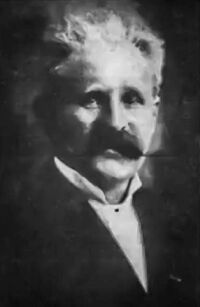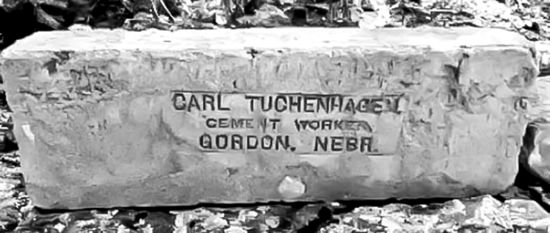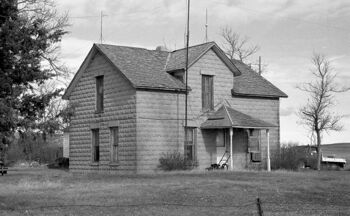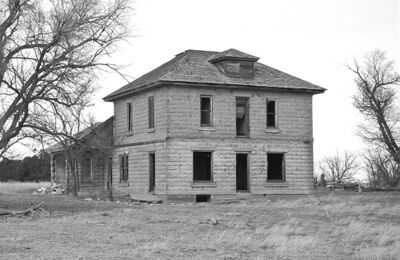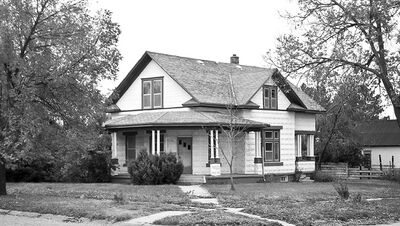Difference between revisions of "Carl Friedrich Wilhelm Tuchenhagen (1860-1941), Mason-Architect"
m |
m |
||
| (3 intermediate revisions by the same user not shown) | |||
| Line 6: | Line 6: | ||
'''Karl Friedrich Wilhelm Tuchenhagen''' was born on September 20, 1860 to Wilhelmine Gross and Johann August Tuchenhagen in the city of Treptow an der Rega, Pomerania, Germany (now Poland). He had one brother and two sisters. [[#References|[1][2][3][5]]] His father was a skilled stonemason, a skill Tuchenhagen brought with him as a young man to Nebraska in 1886. Upon his arrival to America, he changed his name to “Carl” and settled a homestead ten miles north of Gordon. In 1889, he married his wife Johanne Torine Johannedatter Seveland, and they had two children, Minna Elvira Cornelia and Karl Friedrich Wilhelm (Fred). When their children began school, the family moved into the town of Gordon, where Carl began working as a builder. [[#References|[1][2][5][6]]] | '''Karl Friedrich Wilhelm Tuchenhagen''' was born on September 20, 1860 to Wilhelmine Gross and Johann August Tuchenhagen in the city of Treptow an der Rega, Pomerania, Germany (now Poland). He had one brother and two sisters. [[#References|[1][2][3][5]]] His father was a skilled stonemason, a skill Tuchenhagen brought with him as a young man to Nebraska in 1886. Upon his arrival to America, he changed his name to “Carl” and settled a homestead ten miles north of Gordon. In 1889, he married his wife Johanne Torine Johannedatter Seveland, and they had two children, Minna Elvira Cornelia and Karl Friedrich Wilhelm (Fred). When their children began school, the family moved into the town of Gordon, where Carl began working as a builder. [[#References|[1][2][5][6]]] | ||
| − | '''Tuchenhagen''' built his 3,200 square-foot block factory | + | '''Tuchenhagen''' built his 3,200 square-foot block factory around 1887. Because there was little native stone in the area, Carl used cement in molds to create stone-like concrete blocks. He composed his versatile blocks out of sand and cement, and stamped “Carl Tuchenhagen, Cement Worker” on a small percentage of them. Tuchenhagen built primarily homes (there are few known commercial buildings attributed to him), and in each home the blocks were laid carefully to encompass space and provide insulation for comfort. In 1905, The Fair Store, perhaps the largest department store in the area at the time, sought out Tuchenhagen to build “a modern building of cement blocks” to house their store, which has long remained standing, like many of his other buildings. He built concrete stone homes with a signature “Tuchenhagen style,” which is still very visible throughout the town of Gordon. He died on August 29, 1941 at the age of 80. [[#References|[1][2][5]]] |
[[File:CarlTuchenhagenblockstamp 1w.jpg|thumb|center|upright=2.75|alt=CarlTuchenhagenblockstamp 1w.jpg|Stamped concrete block made by Tuchenhagen. (''Knapos, Youtube.com'')]] | [[File:CarlTuchenhagenblockstamp 1w.jpg|thumb|center|upright=2.75|alt=CarlTuchenhagenblockstamp 1w.jpg|Stamped concrete block made by Tuchenhagen. (''Knapos, Youtube.com'')]] | ||
| Line 21: | Line 21: | ||
|[[Image:SH00-085 9711-009-16 1w.jpg|thumb|upright=1.75|alt=DM201304 424 11w.jpg|J.T. Burton House (n.d.). (''NSHS'')]] | |[[Image:SH00-085 9711-009-16 1w.jpg|thumb|upright=1.75|alt=DM201304 424 11w.jpg|J.T. Burton House (n.d.). (''NSHS'')]] | ||
|[[Image:SH00-121 9711-013-25 1w.jpg|thumb|upright=2.0|alt=DM201304 220 11w.jpg|The Murray House (1911). (''NSHS'')]] | |[[Image:SH00-121 9711-013-25 1w.jpg|thumb|upright=2.0|alt=DM201304 220 11w.jpg|The Murray House (1911). (''NSHS'')]] | ||
| − | |[[Image: | + | |[[Image:SH06-004 9710-005-36 1w.jpg|thumb|upright=2.0|alt=SH06-004 9710-005-36 1w.jpg|House (1910). (''NSHS'')]] |
|} | |} | ||
| Line 28: | Line 28: | ||
Tuchenhagen’s Block Factory (1885), Gordon, Nebraska. [[#References|[1]]] | Tuchenhagen’s Block Factory (1885), Gordon, Nebraska. [[#References|[1]]] | ||
| − | + | The Fair Store (1905), Gordon, Nebraska. [[#References|[1][6]]] (SH05-010) | |
| − | Lee and Gottliebe Fritz house (1909), | + | '''[[:Image:SH05-011 9710-002-29 3w.jpg|Lee and Gottliebe Fritz house (1909)]]''', N. Oak St., Gordon, Nebraska. [[#References|[1][6:50]]] [[#Notes|[a]]] (SH05-011) |
| − | + | ||
| − | + | ||
The Springer House (1909), Gordon, Nebraska. [[#References|[1]]] | The Springer House (1909), Gordon, Nebraska. [[#References|[1]]] | ||
| − | The Murray House (1911), south of Rushville, Nebraska. [[#References|[1]]] (SH00-121) | + | '''[[:Image:SH00-121 9711-013-25 1w.jpg|The Murray House (1911)]]''', south of Rushville, Nebraska. [[#References|[1]]] (SH00-121) |
| − | + | '''[[:Image:SH06-004 9710-005-36 1w.jpg|House (1910)]]''', Miller & N 2nd St., Hay Springs, Nebraska.[[#Notes|[c]]] | |
| + | |||
| + | Home (now Seveland House) (1915), Gordon, Nebraska. [[#References|[1]]] | ||
| + | |||
| + | Metzger/Abbot House (ca.1920), Gordon, Nebraska. [[#References|[1]]] | ||
===Undated=== | ===Undated=== | ||
| Line 44: | Line 46: | ||
Tuchenhagen House (n.d.), behind block factory, Gordon, Nebraska. [[#References|[1]]] | Tuchenhagen House (n.d.), behind block factory, Gordon, Nebraska. [[#References|[1]]] | ||
| − | Springman House (n.d.), Elm St., Gordon, Nebraska. [[#References|[1]]] (SH05-001) | + | '''[[:File:SH05-001 7507-018-25z 1w.jpg|Springman House (n.d.)]]''', Elm St., Gordon, Nebraska. [[#References|[1]]] (SH05-001) |
Dalgren House (n.d.), W. Maple St., Gordon, Nebraska. [[#References|[1]]] | Dalgren House (n.d.), W. Maple St., Gordon, Nebraska. [[#References|[1]]] | ||
| Line 56: | Line 58: | ||
Burleigh House (n.d.), near Gordon, Nebraska. [[#References|[1]]][[#Notes|[b]]] | Burleigh House (n.d.), near Gordon, Nebraska. [[#References|[1]]][[#Notes|[b]]] | ||
| − | J.T. Burton House (n.d.), Bingham, Nebraska. [[#Notes|[c]]] | + | '''[[:Image:SH00-085 9711-009-16 1w.jpg|J.T. Burton House (n.d.)]]''', Bingham, Nebraska. [[#Notes|[c]]] |
==Notes== | ==Notes== | ||
| Line 64: | Line 66: | ||
b. Other houses in the Gordon-Rushville area have been built in signature Tuchenhagen style, inspired by his homes, and have been incorrectly attributed to him. While it is true that a major portion of cement block homes in Sheridan County are the work of Tuchenhagen, finding a block stamped with his name is the most concrete assurance of his work. [[#References|[1]]] | b. Other houses in the Gordon-Rushville area have been built in signature Tuchenhagen style, inspired by his homes, and have been incorrectly attributed to him. While it is true that a major portion of cement block homes in Sheridan County are the work of Tuchenhagen, finding a block stamped with his name is the most concrete assurance of his work. [[#References|[1]]] | ||
| − | c. Believed to be Tuchenhagen's due to | + | c. Believed to be Tuchenhagen's due to native sand concrete blocks, general style, and location. |
==References== | ==References== | ||
Latest revision as of 12:33, 27 November 2018
Karl Friedrich Wilhelm Tuchenhagen was born on September 20, 1860 to Wilhelmine Gross and Johann August Tuchenhagen in the city of Treptow an der Rega, Pomerania, Germany (now Poland). He had one brother and two sisters. [1][2][3][5] His father was a skilled stonemason, a skill Tuchenhagen brought with him as a young man to Nebraska in 1886. Upon his arrival to America, he changed his name to “Carl” and settled a homestead ten miles north of Gordon. In 1889, he married his wife Johanne Torine Johannedatter Seveland, and they had two children, Minna Elvira Cornelia and Karl Friedrich Wilhelm (Fred). When their children began school, the family moved into the town of Gordon, where Carl began working as a builder. [1][2][5][6]
Tuchenhagen built his 3,200 square-foot block factory around 1887. Because there was little native stone in the area, Carl used cement in molds to create stone-like concrete blocks. He composed his versatile blocks out of sand and cement, and stamped “Carl Tuchenhagen, Cement Worker” on a small percentage of them. Tuchenhagen built primarily homes (there are few known commercial buildings attributed to him), and in each home the blocks were laid carefully to encompass space and provide insulation for comfort. In 1905, The Fair Store, perhaps the largest department store in the area at the time, sought out Tuchenhagen to build “a modern building of cement blocks” to house their store, which has long remained standing, like many of his other buildings. He built concrete stone homes with a signature “Tuchenhagen style,” which is still very visible throughout the town of Gordon. He died on August 29, 1941 at the age of 80. [1][2][5]
This page is a contribution to the publication, Place Makers of Nebraska: The Architects. See the format and contents page for more information on the compilation and page organization.
Contents
Educational & Professional Associations
1885-1930s: Carl Tuchenhagen, Cement Worker, Gordon, Nebraska. [1]
Buildings & Projects
Dated
Tuchenhagen’s Block Factory (1885), Gordon, Nebraska. [1]
The Fair Store (1905), Gordon, Nebraska. [1][6] (SH05-010)
Lee and Gottliebe Fritz house (1909), N. Oak St., Gordon, Nebraska. [1][6:50] [a] (SH05-011)
The Springer House (1909), Gordon, Nebraska. [1]
The Murray House (1911), south of Rushville, Nebraska. [1] (SH00-121)
House (1910), Miller & N 2nd St., Hay Springs, Nebraska.[c]
Home (now Seveland House) (1915), Gordon, Nebraska. [1]
Metzger/Abbot House (ca.1920), Gordon, Nebraska. [1]
Undated
Tuchenhagen House (n.d.), behind block factory, Gordon, Nebraska. [1]
Springman House (n.d.), Elm St., Gordon, Nebraska. [1] (SH05-001)
Dalgren House (n.d.), W. Maple St., Gordon, Nebraska. [1]
Gordon Shoe Service Shop (n.d.), Main St., Gordon, Nebraska. [1]
Shadak Vault in Gordon Cemetery (n.d.), Gordon, Nebraska. [1]
House on banks of Niobrara River (n.d.),Gordon, Nebraska. [1]
Burleigh House (n.d.), near Gordon, Nebraska. [1][b]
J.T. Burton House (n.d.), Bingham, Nebraska. [c]
Notes
a. This house was a cooperative effort by Tuchenhagen and Glenn Conklin. These two men have been remembered as two of the most important builders in the city. [4]
b. Other houses in the Gordon-Rushville area have been built in signature Tuchenhagen style, inspired by his homes, and have been incorrectly attributed to him. While it is true that a major portion of cement block homes in Sheridan County are the work of Tuchenhagen, finding a block stamped with his name is the most concrete assurance of his work. [1]
c. Believed to be Tuchenhagen's due to native sand concrete blocks, general style, and location.
References
1. Stavros Knapos, “Carl Tuchenhagen” Youtube.com (September 5, 2017). Accessed March 7, 2018 via https://www.youtube.com/watch?v=cJHK4E1dlWk
2. “Carl Tuchenhagen” FindAGrave.com Accessed March 7, 2018 via https://www.findagrave.com/memorial/112471750
3. Ancestry.com. Pomerania, Germany, Parish Register Transcripts, 1544-1883 [database on-line]. Provo, UT, USA: Ancestry.com Operations, Inc., 2015. https://search.ancestrylibrary.com/cgi-bin/sse.dll?_phsrc=GbJ424&_phstart=successSource&usePUBJs=true&gss=angs-g&new=1&rank=1&msT=1&gsfn=carl&gsfn_x=0&gsln=tuchenhagen&gsln_x=0&msbdy=1860&msbpn__ftp=Pomerania,%20Poland&msbpn=31051&msddy=1941&msdpn__ftp=Gordon,%20Sheridan,%20Nebraska,%20USA&msdpn=59317&msrdy=1886&msrpn__ftp=Gordon,%20Sheridan,%20Nebraska,%20USA&msrpn=59317&msrdy1=1920&msrpn1__ftp=Gordon,%20Sheridan,%20Nebraska,%20USA&msrpn1=59317&mssng=johanna%20torine&mssns=seveland&gskw=builder%20carpenter%20architect%20contractor&_83004003-n_xcl=f&catbucket=rstp&MSAV=1&uidh=69a&pcat=ROOT_CATEGORY&h=153863&recoff=10%2013%2060&dbid=8798&indiv=1&ml_rpos=7
4. Christina Slattery, et. al. Sheridan County: Nebraska Historic Buildings Survey (Madison, Wisconsin: Mead & Hunt, for the Nebraska State Historical Society, State Historic Preservation Office, July 1998).
5. “Tuchenhagen” Gordon, Nebraska: Our First Hundred Years (Dallas, Texas: Curtis Media Corporation, 1984), 450-451.
6. Gordon, Nebraska: Our First Hundred Years (Dallas, Texas: Curtis Media Corporation, 1984).
Page Citation
Lydia Allen, “Carl Friedrich Wilhelm Tuchenhagen (1860-1941), Mason-Architect,” in David Murphy, Edward F. Zimmer, and Lynn Meyer, comps. Place Makers of Nebraska: The Architects. Lincoln: Nebraska State Historical Society, March 29, 2018. http://www.e-nebraskahistory.org/index.php?title=Place_Makers_of_Nebraska:_The_Architects Accessed, April 19, 2024.
Contact the Nebraska State Historic Preservation Office with questions or comments concerning this page, including any problems you may have with broken links (see, however, the Disclaimers link at the bottom of this page). Please provide the URL to this page with your inquiry.
